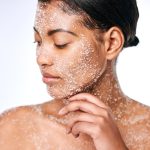Culture’s obsession with bronzed skin has returned. #tanning has 5 billion views on TikTok, sending scores of young adults flocking to tanning beds, salons and drugstore shelves. So, in 2024, what is the best way to tan?
Part of the issue may be that young adults are unfamiliar with the havoc sun damage can wreak on their skin. According to an American Academy of Dermatology survey, 71% of Gen Z adults are unfamiliar with the risks associated with sunburn. 40% are unaware of tanning risks, and 59% believe myths like tanning is healthy and base tans prevent sunburns.
The desire to have glowing, tanned skin is tempting. Therefore, our dermatologists share information about tanning beds, self-tanners and safe tanning methods.
Dangers of tanning beds
Dermatologists everywhere strongly advise against tanning in tanning beds for very good reasons.
For years, people thought indoor tanning booths were safer alternatives to outdoor tanning. Now, we know the shocking correlations between tanning beds and skin cancer, including:
- Nearly half a million skin cancer diagnoses each year are linked to indoor tanning.
- Just one tanning session can increase the chances of developing melanoma by 75% before 35 years of age.
- More people develop skin cancer from tanning beds than develop lung cancer because of smoking, according to the Skin Cancer Foundation.
The danger of tanning beds resides in the powerful ultraviolet (UV) rays they emit to give users a quick tan. Indoor tanning beds expose you to a steady intensity of both UVA and UVB rays, making them even more damaging than being in the sun.
Tanning devices emit UV radiation 10 to 15 times higher than the sun at its highest intensity. This radiation is so intense that it damages the DNA in your skin cells. This can cause premature aging and eye damage and drastically increases your risk of non-melanoma and melanoma skin cancers.
Indoor tanning is especially dangerous for young people. So much so that federal, state and local governments are taking action to protect anyone under 18 from exposure to ultraviolet rays. Today, more than 30 states in the U.S. regulate indoor tanning for people under 18 – and 20 states ban minors from using tanning beds entirely.
The World Health Organization’s International Agency for Research on Cancer categorizes tanning beds with carcinogens like cigarettes and plutonium. So, clearly, this is not the best way to tan!
No benefit to a “base tan”
Some people think a base tan naturally protects against sunburns. Unfortunately, this is a tanning myth. Base tans damage the skin just as much as regular tanning.
Tans develop as a response to injury from UV rays. This means that base tans harm your skin and do not protect you from future UV damage. The healthiest way to avoid sunburns is by using sunscreen and SPF-protective clothing.
Tanning is not a healthy treatment for psoriasis
Early in 2024, skincare brand founder Kim Kardashian showed off a tanning bed and a red light bed in her office. Fans found this baffling but speculated that it may be used to treat her psoriasis.
While dermatologists sometimes use UV treatments for psoriasis, these are controlled, single UVB waves used for a few seconds for medical treatment.
Natural sunlight and indoor tanning beds shine with hundreds of UVA and UVB wavelengths for much longer. As a result, psoriasis patients who self-treat by tanning often end up seeing their dermatologist to remove pre-cancers, examine concerning spots and treat skin cancers from the UV damage.
If you are experiencing psoriasis, contact our experienced dermatologists to identify better, healthier options to treat your skin condition.
Self-tanning alternatives – Are they safe?
Many people have turned to self-tanners to get a healthy glow without harming their skin outdoors or at a tanning salon. The sunless tanning market is exploding, with a projected growth of 45% by 2030. Lotions and gels are the most popular, with advocates touting benefits like hydration, reduced breakouts and refreshed skin.
Self-tanning products offer users a bronzed glow without the risk of UV damage. The active ingredient in sunless tanning products is dihydroxyacetone (DHA). This FDA-approved chemical reacts with the skin to create melanoidins, which turn the skin brown.
Unfortunately, DHA increases free radicals in the skin, which break down collagen and elastin. If the DHA in your self-tanner reaches the lower layers of your skin, it could cause faster skin aging or wrinkles.
You can find self-tanning products containing DHA in lotions, sprays, foams and wipes. Most of these products are fast-acting and will give your skin a darker appearance in a few hours or less.
Another option is a spray tan, which can give you a beautiful all-over glow without harmful UV exposure. Spray tanning uses DHA to deliver an instant bronze, and they typically offer a more even tan without the mess of self-tanners.
Doctors recommend wearing a mask when obtaining a spray tan to protect your lungs from the DHA and using drops, lotions or gels for the face.
New products on the self-tanning scene include vitamin supplements with lycopene and astaxanthin and nasal sprays. These options are not FDA-approved nor are they recommended by our dermatologists.
Lycopene is a carotenoid found in carrots, tomatoes and watermelons that contributes to their bright coloring. Some people have begun taking these supplements to color their skin. While they work for some, the FDA does not recommend these products for tanning. Also, overuse of these supplements can lead to liver and eye damage.
Nasal tanning sprays are so dangerous that they have been banned in the US and UK. The main ingredient of nasal tanning sprays is Melanotan II. According to the Cleveland Clinic, Melanotan II replicates hormones in the body and increases the risk of skin cancers, skin spots, acne, kidney problems, muscle disintegration and more.
What are the best self-tanning products?
“Of course, we always recommend spray tanning and self-tanning over sun tanning or UV tanning,” says Dr. Asha James, a dermatologist at Columbia Skin Clinic. “There are so many high-quality sunless tanners on the market. I tell patients to try them out to see what works best for their skin tone and skin type.”
Recommended brands include:
- Bondi Sands
- Illusion Bronze
- tanned AF
- All the Buzz FAB Fashion
- Coco & Eve
- Tanology
- St. Tropez
How to maintain healthy, glowing skin this summer
First and foremost, protect your skin by using sunscreen with a broad-spectrum protection SPF of at least 30. Limit direct exposure to the sun and reapply sunscreen every two hours. Then, modify your summer skincare routine to meet your face’s needs and minimize breakouts:
- Lighten up by switching your thicker winter moisturizer to a gel-based lotion or lighter-weight moisturizer.
- Switch to oil-free or non-comedogenic products to reduce oil.
- Add a cleanser geared towards acne if you regularly break out over the summer months.
- Remember to exfoliate your face to unclog pores that may have been blocked by the extra oil production.
- Find out more about how to get summer skincare ready.
Schedule a regular skin cancer screening with your dermatologist. Columbia Skin Clinic’s board-certified dermatologists offer in-office skin cancer screenings at all of our convenient Midlands locations. Contact us to schedule an appointment today.






